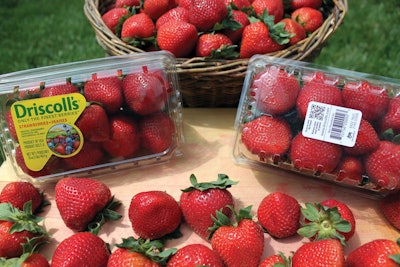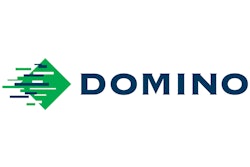
Cool Pak LLC, Oxnard, CA, specializes in the design, development, manufacturing, labeling, and distribution of customized packaging solutions for fresh fruit and vegetable products. The company’s customer base includes fresh produce growers, shippers, and packers.
Cool Pak thermoforms clamshells and containers primarily from recycled PET (RPET) and has developed a broad manufacturing base in the United States, Mexico, Taiwan, China, and Chile, with labeling and distribution facilities in Oxnard, Bakersfield, and Santa Maria, CA, as well as in British Columbia, Canada and Guadalajara, Mexico. The company’s typical containers incorporate 85% RPET, but Cool Pak also can produce packaging made from 100% RPET, at customer request. In addition, Cool Pak offers containers made from corn-based biodegradable PLA (Polylactic Acid) polymer. For modified atmosphere packaging applications, Cool Pak can provide customized lidding films, barrier film bags that are inserted into its clam shells, and micro-perforated rigid containers to manage fresh produce respiration rates.
Labeling latitude
As part of its pre-labeled packaging services, Cool Pak also supplies labeling solutions for branding, product identification, traceability, and food safety for its diverse customer base. To accommodate these variable-print labeling needs, Cool Pak had found itself needing to purchase approximately 600 million variable preprinted trace labels per year. This was proving to be expensive and inventory intensive. So the company decided to bring variable label printing/converting in-house.
Cool Pak General Manager Niall Kelly notes, “We were starting to buy hundreds of millions of variable trace labels, utilizing three or four label partners. In addition to the cost considerations, we also were encountering some print quality issues and lead time issues. So for control reasons, cost reasons, and service reasons, bringing label printing in-house became a strong consideration.”
Variable printing technology was key. As Kelly explains, “Trace technology requires a variable component. Every label has a unique identifier on it. We realized that, by having variable print technology in-house, we could generate both human readable and DataMatrix or QR (Quick Response) codes. We then could ink jet print those codes onto a web of labels while on press. These labels then could be applied to the clamshells and other containers.”
After evaluating various label printing options to meet its requirements, Cool Pak chose the digital UV ink jet printing technology available from Domino.
Selection process & parameters
Kelly recalls, “Prior to Domino, we had invested in another ink jet technology, but we knew it wasn’t going to meet the quality and speed requirements for our larger volume business. So we talked to a lot of people and searched around, and a couple of roads led us to Domino. In fact, one of our competitors told us that, if we were going to do this right, there was really only one choice, and that was Domino. When a competitor tells you that, you have to be careful. But it was absolutely the right choice for us. I flew out to Domino in Gurnee, IL, in October 2012, observed the Model K600i in operation, and made the decision in November.”
Kelly and his team observed the K600i in action using Cool Pak’s real data. During the observation, they took into account such critical factors as print density and quality, speed, ink cost, ease of use, and ease of maintenance and automated print head cleaning.
“We ran various resolutions…300 x 300dpi, 300 x 600dpi, 600 x 600dpi, and at various Pico liter settings. We wanted to get a good handle on what our costs were going to be as part of the system purchase justification. We ran 20 feet or so at one density and specification, then bumped up the resolution or dropped Pico liter setting, etc. It was extremely easy to make those types of changes to evaluate the technology. Right then and there, I knew at what settings we would run the press when we got it into production. And then the Domino team ran some numbers on ink consumption so that I could cost-justify the system from that perspective. It was all pretty exciting,” says Kelly.
Saving money & time
In total, Cool Pak produces more than 3 billion labels per year, including about 600 million trace labels. Annual variable printed trace label costs were cut in half by installation of the Domino digital ink-jet printing system. “It cost us about twice as much to buy these labels out-of-house,” says Kelly. “And we also reaped valuable lead time and inventory efficiency advantages. Our business can be very unpredictable because produce harvests are often unpredictable, driven by weather conditions. So having the label printing technology in-house allows us to create labels on a more efficient, just-in-time basis. We don’t need to keep a lot of preprinted inventory. We don’t have to pre-run a bunch of labels and then end up with wasted labels if harvesting plans go off schedule or off estimate.”
One of the major fresh produce companies to which Cool Pak supplies containers and labels is the berry producer Driscoll‘s, Watsonville, CA. For the Driscoll’s clam shells, the top labels are printed and converted on a Model 2200 flexographic label press from Mark Andy. Bottom labels bearing the variable product data (including HarvestMark, bar codes, and human-readable product ID) are printed by the Domino K600i.
Driscoll’s not only uses the Domino-printed bottom labels for food safety and traceability, but also as an important consumer communications tool. By scanning the QR code with a smart phone, consumers can link up to Driscoll’s Consumer Advisory Panel page and participate in on-line surveys. Consumers who provide product and package feedback are eligible for coupons and special prize drawings. They also can access recipes, product care and handling tips, and information about Driscoll’s complete product line and retailer locations.
The Domino K600i is printing Cool Pak trace labels at about 230 feet per minute. Kelly notes, “We haven’t encountered any downtime. We haven’t had issues with ink. And ease of use from the operator standpoint is really great. We run the press 24 hours per day, but we don’t run the Domino ink jet 24 hours per day. We might turn it off two or three times a day. So it’s very important that when we turn it on, it works immediately. We can’t have start-up issues or increased make-ready time. With the Domino, we haven’t had any of that. And the print quality and ability to adjust Pico liter levels without sacrificing quality is a big deal for us. We can dial in the quality requirements as the job dictates.”
Summing up, Kelly says, “Installation of the Domino K600i was a big decision for us financially and technology-wise. It sets the direction we are going to go for a long time. There have been zero regrets. We are very happy with the decision we made.”


























